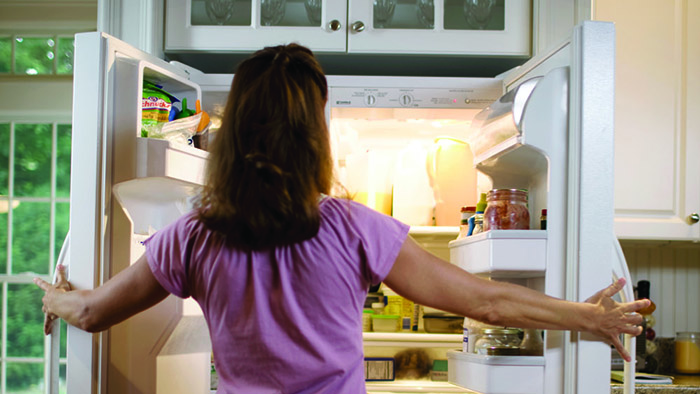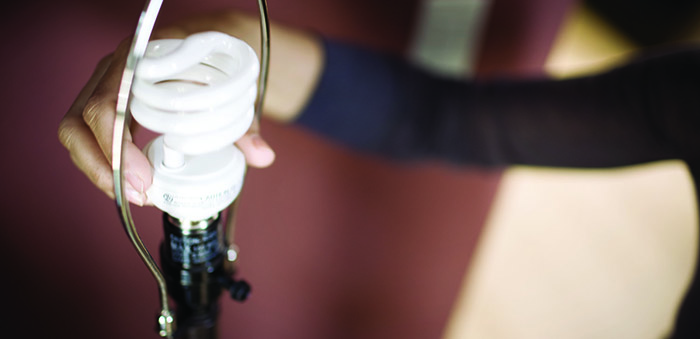
Heating and cooling make up the largest portion of your energy bill and offer the most in potential savings. Try these tips to help lower your heating and cooling costs.
Summer savings
- Set your thermostat at 78 degrees. Experts say this is the optimal temperature for keeping cool while saving energy. Each degree higher will save you even more.
- Install a programmable thermostat. With it you can automatically adjust your HVAC to energy saving temperatures. According to ENERGY STAR, the device could help you save up to $180 per year.
- Replace your HVAC. You can save a bundle by swapping out your HVAC for a more efficient unit.
- Change your air filter. You should regularly replace your air filter (every one to three months). According to the U.S. Department of Energy, replacing a dirty filter could cut cooling costs by as much as 15 percent.
- Plant trees. Strategically placed trees can reduce an unshaded homes energy costs by up to 50 percent!
- Use your ceiling fan. Turn up the air conditioner and turn on your ceiling fan. Using a fan at the highest setting can cool you by up to 4 degrees.
- Cook outside. Fire up the grill and avoid using the oven. Your oven will only heat your home and increase your electricity bill.
- Seal air leaks. It's estimated that the average home has enough air leaks to add up to a 2 square foot hole! Check the interior and exterior of your home for cracks and crevices that might allow cold air to leak from your house. Seal these problem areas with caulk or weatherstripping.
- Keep windows covered. The hot Texas sun will only make your home hotter if it’s allowed through your windows. Keep drapes, blinds and shades closed tight to save energy.
Winter Savings
-
Set your thermostat at 68 degrees. Experts say this is the optimal temperature for keeping warm while saving energy. Turn it down even lower for more savings.
-
Reverse your ceiling fan. In the winter time, reverse your ceiling fan so it spins in the opposite direction. The simple change will help push warm air down from the ceiling so you stay toasty.
-
Dress for the weather. Wear sweaters, pants and socks, even when you’re inside. The warmer layers will keep you from adjusting the thermostat.
-
Open your blinds. In the winter time, the sun can help warm your home naturally. Open your drapes and blinds to allow the warmth in.
-
Replace your windows. ENERGY STAR certified windows can cut heat loss by as much as 30 percent.

As the hub of any household, the kitchen is one of the most frequently used rooms. Cutting back on the electricity used in your kitchen is a surefire way to find savings on your energy bill. Just follow these tips and see what you could save!
- Keep the lids on your pans. Not only does this prevent heat waste, it will also cook your food faster and use less energy.
- Use the right size pan in the kitchen. A 6-inch pan on an 8-inch burner will waste more than 40% of the heat produced.
- Turn off electric burners. Switch burners off a few minutes before you’re done cooking. The residual heat will finish the job.
- Clean your reflector pans. The reflector pans on your stovetop reflect heat upward and work best when they aren’t blocked by grease. A clean pan is an efficient pan.
- Use cold water for cooking. It heats faster and costs you less.
- Don’t open the oven to check on your dinner. It lowers the temp by 25 degrees and wastes energy. Use the light instead.
- Use small appliances. Instead of the oven, use small appliances such as a microwave, toaster oven or slow cooker. They use less energy and won’t add much heat to your home.
- Get rid of your extra fridge. Using a second refrigerator can cost an extra $120 a year. Unplug it and save.
- Keep your fridge full. Pack cold items together to keep your fridge cool. It’s more efficient than an empty one.
- Cover food and drinks in the fridge. Uncovered goods release moisture that makes the fridge work harder.
- Set the right temperature. The ideal temperature for your refrigerator is 37-40 degrees Fahrenheit. For the freezer it’s 0 degrees Fahrenheit. Anything colder just wastes energy.
- Unplug unused appliances. Electronics, such as your coffee maker or toaster, can still suck power from the outlet, even when they aren’t being used. Unplug appliances to save.
- Wash full loads of dishes. If you wait until the dishwasher is full to run it, you’ll run it less over its lifetime and save on water heating costs too.
- Air dry your dishes. Instead of using your dishwasher’s heat dry function, open the machine and let your dishes air dry to save energy.
- Buy ENERGY STAR appliances. If you’re looking to upgrade outdated kitchen appliances, find models with the ENERGY STAR label. They use less electricity than non-certified models.

Although the bathroom isn't the largest room in the house, it still offers plenty of opportunities for energy savings. Try out these tips to see if you can save in your bathroom.
-
Turn the water off. Don’t leave the water running, turn it off when it’s not being used.
-
Collect water from your shower. Stick a bucket in the shower to collect cold water while you wait for it to warm up. Instead of wasting it, you can use the water in your garden or on your lawn.
-
Install a low-flow shower head. These handy shower fixtures can cut water waste by up to 50 percent as well as your hot water heating costs.
-
Take shorter showers. You’ll not only save water but you’ll save on water heating costs.
-
Fix leaks quickly. A leaky faucet, dripping once per second, wastes 3,153 gallons of water per year. If it’s warm water, you’ll pay a lot extra on your electricity bill too.
-
Turn vent fans off. Vent fans are essential for discouraging mold, but they shouldn’t be left on long. After about 15 minutes, head back to the bathroom to turn the fan off.
-
Unplug your electronics. Bathroom gadgets, such as a hair dryer, curling iron or electric razor, should be unplugged from the wall when you're finished with them. These devices can still draw electricity from the outlet, even when they are off.
-
Make your faucet more efficient. Replace the aerator-- the screw-on tip of the faucet – with a new model. These newer options use as little as 0.5 gallons per minute while older models use about 2.2 gallons per minute.
-
Replace your toilet. If you’ve had the same toilet since the 90s, it’s time for an upgrade. A new single-flush toilet uses just 1.6 gallons per flush and could save a family of four up to 25,000 gallons of water per year.

The laundry room is probably one of the smallest rooms in your house, but it makes a big impact on your electricity bill. The average American family washes more than 400 loads of laundry, which puts your electricity bill through the ringer. Want to save? Try these tips.
-
Wash your clothes in cold water. About 90 percent of the energy used by your washer comes from water heating, so you’ll save a load if you wash with cold water.
-
Wash full loads of laundry. A large load uses just as much energy as a small load. Get more bang for your buck by filling up your machine.
-
Use the highest spin-cycle. Using the fastest spin cycle on your washer reduces moisture in your clothes and can reduce drying time by 50 percent.
-
Upgrade to an ENERGY STAR washer. They use 35 percent less water and 20 percent less energy than a standard model.
-
Clean your dryer’s lint screen. Cleaning the screen after every load will improve your dryer’s circulation, improve efficiency and prevent fire hazards.
-
Don’t over dry your clothes. If your dryer has a moisture sensor, use it. There’s no point in keeping your dryer running if the clothes are no longer wet.

Try one (or all) of these simple tips to save on electricity costs throughout your entire home!
- Ditch the incandescent bulbs. Only 10 percent of the energy used by incandescent bulbs is used for light. The rest just heats the bulb.
- Switch to CFLs. Compact Fluorescent Light bulbs last 10 times longer than incandescent lights and use just a quarter of the energy.
- Or try LEDs. LED light bulbs are the most efficient option on the market. They are 75 percent more efficient and last up to 25 times longer than incandescent lights.
- Don’t leave lights on for your pet. Lights disrupt your pet’s sleep schedule and waste your hard-earned dollars. Turn the lights off when you’re not home.
- Use motion sensor lights outside. These lights will automatically turn on when you need them and off when you don’t.
- Turn down your hot water heater. Many hot water heaters come preset at 140 degrees, but that’s much hotter than you actually need. Turn the dial down to 120 degrees to save.
- Make your water heater more efficient. Wrap an insulating blanket around your hot water heater. You’ll reduce heat loss by 25 to 45 percent.
- Limit hot water heating. Install a timer on your hot water heater to turn it off during low usage times, when you’re at work, sleeping or traveling.
- Rearrange your furniture. Make sure none of the furniture in your home is blocking an air vent so your heating and cooling can flow easily through your house.
- Unplug unused electronics. Electronic devices can still use energy when they are switched off. Unplug them completely and you could save up to $100/year according to the U.S. Department of Energy.
- Shut your computer down. Leaving it in standby mode still uses electricity and costs you money.
